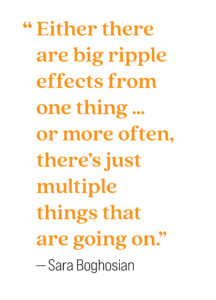CENTER OF ATTENTION: USU’s Sorenson Center for Clinical Excellence is a Resource for the Entire State

By Timothy R. Olsen, ’09, M.B.A. ’18
Mental health concerns are on the rise across the United States throughout all demographics. Data from the Center for Disease Control and Prevention’s Behavioral Risk Factor Surveillance System shows nearly 16% of adults nationwide report “frequent mental distress” — a more than 4% increase since 2017.
Those percentages are even higher in Utah, especially amongst women, as more than 20% reported their mental health was not good for 14 or more days in the past 30 — the baseline measurement for frequent mental health distress.
And, while there are myriad factors that affect a person’s mental health, the Sorenson Legacy Foundation Center for Clinical Excellence at Utah State University, through its integration of research, academic, and clinical services is working to understand those factors better while also providing insight and treatment.
“We study these things as isolated incidences, so we can understand them. But I don’t believe I’ve ever worked with somebody who had just one thing going on,” says Sara Boghosian, a clinical assistant professor in USU’s psychology department. “Either there are big ripple effects from one thing — so now we’ve got a bunch of little fires to put out in addition to the big fire — or more often, there’s just multiple things that are going on.”
Boghosian, who is originally from California, received her doctoral degree from USU in 2011 and then returned to the university as an employee in 2015.
Though the center, which opened in 2018, is located on Utah State University’s Logan campus and housed within the Emma Eccles Jones College of Education and Human Services, it doesn’t only cater to students. While it is a training facility for graduate students within various disciplines — marriage and family therapy, speech language pathology, audiology, psychology, and social work, amongst others — those students are closely supervised by knowledgeable and experienced faculty.
“I think maybe not everyone realizes that we’re a community-facing clinical services building. We’re not here just for students — students can come here, but that’s not really our mission. Our mission is to provide services to the community of Cache Valley, and actually to the state of Utah, because we can do telehealth … most of our services can be done wherever you are in the state.”
Chronic Pain: Not A Day at The Beach

A native of Germany, Maria Kleinstaeuber has spent more than a decade studying the line between mental and physical health and applies both a clinical and health psychology perspective in her current role as assistant professor in the Combined Clinical and Counseling Psychology Ph.D. program at USU.
Her main area of focus is Somatic Symptom Disorders or SSD, which is the phenomenon of having difficulties adjusting to persistent physical symptoms, such as chronic pain or tinnitus (constant ringing or buzzing in the ears), and then developing psychological distress as a reaction to that persistent discomfort.
Kleinstaeuber says she and her team have been doing a lot of research on the process or lifecycle of a symptom as it moves from being an acute occurring symptom into a persistent and disabling one. She says not a lot is known about that process at the moment, but they’re trying to identify factors early in the symptom-developing process that will help predict how people will do later.
“For patients, it’s really so important to understand that pain itself is the phenomenon that actually develops in our brain,” Kleinstaeuber says. “And then also not just considering the brain as there is one pain center, very simplistic, but within the brain we have a complexity of different centers that are constantly in interaction with each other … like our emotion center, or the center of our brain that triggers the stress response, and so on. That directly connects with the rest of the body and makes it clear there are so many points where somebody can address the pain through their complexity.”
Put simply, while the aching in your lower back from a herniated disc might be the big splash you see when you throw a rock into the still water of a pond, the ripples emanating out from that initial point of impact affect the entire entity. Your mood, ability to handle stress, interactions with others, appetite, and various other factors are all affected by the amount of energy spent mentally dealing with constant pain.
Boghosian likens coping with pain or distress to attempting to hold a beach ball underwater at the lake. She says while the task of holding a beach ball under the water is certainly doable, it takes all your energy, all your focus to do it. Meanwhile, while you’re wrestling with the beach ball, everyone else is engaging with each other and their surroundings. They’re enjoying the day at the lake while you’re there, wrestling with that beach ball.
“That’s what it is to try to hold pain at bay, be it emotional pain or physical pain,” Boghosian exhorts. “You just miss so much, right? And you start to view your body as the enemy, and you stop listening to it completely or you become hypervigilant to cues from your body and find yourself responding in ineffective ways.”
Eating Disorders: Learning to Listen to Your Body
There are a variety of common stereotypes that accompany eating disorders. Categorizing those struggling with anorexia nervosa as extremely underweight or those dealing with bulimia nervosa, or binge-eating disorder, as very overweight are just a few examples of those common misconceptions.
However, in reality, it doesn’t play out that way. Those extremes are more often the exception than the rule says Rachel Rood (’92, ’94), a registered dietitian who works in the Sorenson Center’s Behavioral Health Clinic, but also operates her own private practice.
“I’ve seen people at normal weights with binge eating disorder and I’ve seen people at normal weights with pretty severe, restrictive, anorexic behaviors. Different bodies respond to food behaviors differently,” she says. “I think it’s really more about focusing on the person’s relationship with their food and their bodies.”
Rood, who spent more than 12 years as the lead dietitian at a residential eating disorder treatment facility, says one of the side effects of dealing with eating disorders that doesn’t get talked about enough is the affect they have on relationships. She points out that most social gatherings involve some kind of food element, which can lead to social avoidance or isolation for those dealing with eating disorders or unhealthy relationships with food.
While eating disorders have long been a struggle, Boghosian, who, like Rood, specializes in that area, says she’s noticed an increase in a specific type over the past few years, largely due to social media.
Orthorexia nervosa — though not listed as an official diagnosis in the Diagnostic and Statistical Manual of Mental Disorders — can best be described as an obsession with healthy eating and its associated restrictive behaviors. Boghosian says that though eating disorders have always generally affected all demographics, orthorexia used to be most predominant in wealthier neighborhoods. However, with the ease of access to social media and the rise of influencer culture, those barriers have been broken.
“You just have so much more access to folks who are talking about stuff that isn’t very science-based and it’s kind of cloaked as wellness,” Boghosian laments. “I’m very, very worried about the influencer wellness community, because I think what’s being recommended, really, really appeals to someone who has a predisposition to develop anorexia. Food is kind of branded as both the solution to all the ills of the world in those communities, but also as kind of the devil.”
Both Boghosian and Rood advocate for intuitive eating, an approach popularized in the mid-’90s by Evelyn Tribole and Elyse Resch and their book Intuitive Eating: A Revolutionary Program That Works. While there are 10 principles in the book, Rood says the two overarching principles are to eat consistently to avoid getting overly hungry, but then to stop eating once your body reaches “gentle fullness.”
While this idea sounds simple on the surface, Rood says there are a variety of reasons people might not get consistent hunger or fullness cues. Because of this, people have to learn to be attuned to their bodies, which can take some time and practice.
“I think the biggest thing is people think, ‘Well, that won’t work for me. If I let myself have whatever I want I’ll eat too much, I’ll eat too much of the wrong things,’” Rood says. “People think, ‘Well, if I eat more often during the day, I’m going to eat way too much.’ Right? But when we’re eating, when we’re just gently hungry, it’s much easier to stop at gentle fullness rather than if we don’t eat all day and we’re ravenous when we get home. And that’s what I see a lot of.”
Perfectionism: Solutions Through Acceptance and Commitment Therapy

Korena Klimczak and Marissa Donahue are both graduate students at USU working towards a degree in the Combined Clinical and Counseling Psychology Ph.D. program. The duo constitutes 20% of the 10-student cohort of the Acceptance and Commitment Therapy (ACT) Research Group.
That group is dedicated to research, training, and clinical services based on Acceptance and Commitment Therapy, which is a form of psychological intervention that uses acceptance and mindfulness strategies in conjunction with commitment and behavioral-change strategies to increase psychological flexibility.
In other words, the goal of ACT is to help people develop acceptance of unwanted personal experiences that are out of their control, while also providing pathways toward living a valued life. Klimczak describes it as being able to live your best life or be your best self when you are in touch with your values.
As part of the ACT Research Group, and at the time of this writing, Klimczak and Donahue are in the midst of leading a group therapy session geared towards dealing with perfectionism. The idea for the group is loosely based off a book — The Anxious Perfectionist — written by USU professor of psychology Dr. Michael P. Twohig who also serves as one of the directors of the ACT Research Group.
“There are all kinds of things that get in the way of pursuing our values, right? Like, I’m too anxious to do that, or I feel too sad to get out of bed,” says Klimczak, who is in the fifth year of her program. “And so, applying this kind of theory to perfectionism, it’s all about how your perfectionism gets in the way of living your values.”
It would be easy to assume that perfectionism simply means striving to be perfect all the time, but Donahue, who is in her fourth year, says it goes a lot deeper than that. She recalls a time during her training where she was hit with an “Aha!” moment, realizing perfectionism isn’t just about achievement, but also the avoidance of failure. That even though someone may not be striving to be the best all the time, they’re spending an inordinate amount of time and energy trying not to fail, which is a side of perfectionism not often discussed or recognized.
“People that really hold themselves to high standards and are very achievement oriented, I think that’s a part of it,” Donahue says. “I think another part is the presence of really self-critical thoughts around those expectations and rules that people have for themselves, as well as self-worth being tied into performance. I think those are three different categories.”
As they’ve been leading the group, Klimczak and Donahue say one of the biggest surprises for them has been the varying age range of the participants. Initially they expected mostly college-aged people in the group, but instead ended up with a wide range of ages from 18 to 60. And, along with that diverse age range, they’ve been able to work with individuals at different levels in their own efforts of trying to cope with perfectionism.
These areas of focus — chronic pain and tinnitus, eating disorders, perfectionism — are just a small window into the Sorenson Center’s offerings. With opportunities for research, teaching, and collaboration, it is not just a resource for Utah State University students, faculty, and staff, be for residents throughout the state of Utah.
“I think everyone from a 2-year-old to however old we’re living these days, we have a lot of services across the lifespan here at the Sorenson Center,” Boghosian says. “There’s a lot going on here, a lot that’s innovative.





